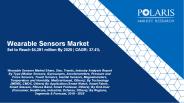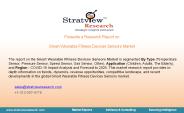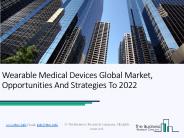Wearable Sensors PowerPoint PPT Presentations
All Time
Recommended
The wearable sensors market is expected to grow from USD 189.4 Million in 2015 to USD 1,654.0 Million by 2022, at a CAGR of 30.14% between 2016 and 2022.
| PowerPoint PPT presentation | free to download
Data Bridge Market Research analyses the wearable sensors market will exhibit a CAGR of 46.75% for the forecast period of 2022-2029. In continuous physiological observation or tracking, a wearable sensor assists with less manual interference and low cost. Such sensors assist in the collection and transmission of information about their surroundings, as well as navigation. Wearable sensors are currently found in a wide range of devices, including wristwatches, headgear, glasses, cell phones, shoes, shirts, and headphones.
| PowerPoint PPT presentation | free to download
Wearable sensors market
| PowerPoint PPT presentation | free to download
The worldwide Wearable Sensors Market is anticipated to reach around USD 4,281 million by 2026 according to a new research published by Polaris Market Research. Get Sample Copy @ https://www.polarismarketresearch.com/industry-analysis/wearable-sensors-market/request-for-sample
| PowerPoint PPT presentation | free to download
Data Bridge Market Research analyses the wearable sensors market will exhibit a CAGR of 46.75% for the forecast period of 2022-2029.
| PowerPoint PPT presentation | free to download
The overall wearable sensors market was valued at USD 189.4 million in 2015 and is expected to reach USD 1,654.0 million by 2022, growing at a CAGR of 30.14% between 2016 and 2022. See Full Report: https://goo.gl/wDs9jT
| PowerPoint PPT presentation | free to download
Geographically, this report is segmented into several key Regions, with production, consumption, revenue million USD, market share and growth rate of Wearable Motion Sensors in these regions, from 2013 to 2025 forecast, covering United States EU China Japan South Korea Taiwan
| PowerPoint PPT presentation | free to download
Smart Wearable Fitness Devices Sensors Market, By Type (Temperature Sensor, Pressure Sensor, Speed Sensor, Gas Sensor, Other), Application (Children, Adults, The Elderly), and Region - COVID-19 Impact Analysis and Forecast to 2026
| PowerPoint PPT presentation | free to download
According to MRFR, the Global Wearable Sensors Market is poised to mature at a CAGR of 46.73% and is anticipated to reach USD 11.07 Billion by 2025.
| PowerPoint PPT presentation | free to download
The wearable sensors market is expected to grow from USD 189.4 Million in 2015 to USD 1,654.0 Million by 2022, at a CAGR of 30.14% between 2016 and 2022
| PowerPoint PPT presentation | free to download
the overall wearable sensors market was valued at USD 189.4 Million in 2015 and is expected to reach USD 1,654.0 Million by 2022, growing at a CAGR of 30.14% between 2016 and 2022
| PowerPoint PPT presentation | free to download
Wearable sensor market global forecast report categorizes global market by Type (Accelerometers, Magnetometers, Gyroscopes, Image Sensors, Inertial Sensors, Temperature & Humidity Sensors, Pressure & Force Sensors, Touch Sensors and Motion Sensors), Application (Wristwear, Eyewear, Bodywear), Vertical, and Geography.
| PowerPoint PPT presentation | free to download
The wearable sensors market is expected to grow from USD 189.4 Million in 2015 to USD 1,654.0 Million by 2022, at a CAGR of 30.14% between 2016 and 2022
| PowerPoint PPT presentation | free to download
To Know More : https://bit.ly/2rEqOtS Wearable Motion Sensors Market studies the global Wearable Motion Sensors market status and forecast, categorizes the global Wearable Motion Sensors market size (value & volume) by manufacturers, type, application, and region. Wearable Motion Sensors Market focuses on the top manufacturers in United States, Europe, China, Japan, South Korea and Taiwan and other regions.
| PowerPoint PPT presentation | free to download
Request for TOC report @ http://bit.ly/2oFE5Pi Wearable Sensors Market size is anticipated to witness a surge during the forecast period. This industry is predicted to witness massive growth due to the rising need across several application areas; for instance, lifestyle and security, fitness and healthcare. These sensors detect, monitor, process and analyze the environment.
| PowerPoint PPT presentation | free to download
The wearable sensors market is expected to grow from USD 189.4 Million in 2015 to USD 1,654.0 Million by 2022, at a CAGR of 30.14% between 2016 and 2022
| PowerPoint PPT presentation | free to download
The wearable sensors market is expected to grow from USD 189.4 Million in 2015 to USD 1,654.0 Million by 2022, at a CAGR of 30.14% between 2016 and 2022.
| PowerPoint PPT presentation | free to download
The wearable sensors market is expected to grow from USD 189.4 Million in 2015 to USD 1,654.0 Million by 2022, at a CAGR of 30.14% between 2016 and 2022.
| PowerPoint PPT presentation | free to download
The environmental sensor market is estimated to be worth USD 1.37 billion in 2018 and is projected to reach USD 2.19 billion by 2023, at a CAGR of 9.9% from 2018 to 2023. The growth of this market can be attributed to stringent environmental regulations to reduce air pollution, increase in health and safety concerns, and rise in air quality monitoring stations.
| PowerPoint PPT presentation | free to download
The global wearable sensor market is expected to provide tremendous growth potential for market players in the near future, as the market is in its nascent stage of growth. High cost of these devices is a major limitation for the industry. However, recent innovations including flexible, printed electronics and compatibility with consumer electronics have increased the efficiency of the new devices, which in turn has increased their adoption in various applications. Request Sample@ https://www.alliedmarketresearch.com/request-sample/1939
| PowerPoint PPT presentation | free to download
The Global Wearable Sensors Market accounted for USD 320.82 million in 2017 and is projected to grow at a CAGR of 30.2% during the forecast period of 2018 to 2025. The upcoming market report contains data for historic years 2016, the base year of calculation is 2017 and the forecast period is 2018 to 2025.
| PowerPoint PPT presentation | free to download
The wearable sensors market is expected to grow from USD 189.4 Million in 2015 to USD 1,654.0 Million by 2022, at a CAGR of 30.14% between 2016 and 2022.
| PowerPoint PPT presentation | free to download
The wearable sensors market is expected to grow from USD 189.4 Million in 2015 to USD 1,654.0 Million by 2022, at a CAGR of 30.14% between 2016 and 2022.
| PowerPoint PPT presentation | free to download
The Global Wearable Sensors Market accounted for USD 320.82 million in 2017 and is projected to grow at a CAGR of 30.2% during the forecast period of 2018 to 2025. The upcoming market report contains data for historic years 2016, the base year of calculation is 2017 and the forecast period is 2018 to 2025.
| PowerPoint PPT presentation | free to download
The Global Wearable Sensors Market accounted for USD 320.82 million in 2017 and is projected to grow at a CAGR of 30.2% during the forecast period of 2018 to 2025. The upcoming market report contains data for historic years 2016, the base year of calculation is 2017 and the forecast period is 2018 to 2025.
| PowerPoint PPT presentation | free to download
The wearable sensors market is expected to grow from USD 189.4 Million in 2015 to USD 1,654.0 Million by 2022, at a CAGR of 30.14% between 2016 and 2022
| PowerPoint PPT presentation | free to download
The Global Wearable Sensors Market accounted for USD 320.82 million in 2017 and is projected to grow at a CAGR of 30.2% during the forecast period of 2018 to 2025. The upcoming market report contains data for historic years 2016, the base year of calculation is 2017 and the forecast period is 2018 to 2025.
| PowerPoint PPT presentation | free to download
Global Wearable Sensors Market, By Type (Accelerometers, Gyroscopes, Temperature & Humidity Sensors, Magnetometers, Image Sensors, Pressure & Force Sensor, Inertial Sensor, Touch Sensors, Medical Based Sensors, Motion Sensors, Microphones), By Technologies, By Application By End User, By Geography (North America, Europe, Asia-Pacific, Europe, South America, Middle East & Africa) – Industry Trends and Forecast to 2025
| PowerPoint PPT presentation | free to download
Global Wearable Sensors Market, By Type (Accelerometers, Gyroscopes, Temperature & Humidity Sensors, Magnetometers, Image Sensors, Pressure & Force Sensor, Inertial Sensor, Touch Sensors, Medical Based Sensors, Motion Sensors, Microphones), By Technologies, By Application By End User, By Geography (North America, Europe, Asia-Pacific, Europe, South America, Middle East & Africa) – Industry Trends and Forecast to 2025
| PowerPoint PPT presentation | free to download
The Global Wearable Sensors Market accounted for USD 320.82 million in 2017 and is projected to grow at a CAGR of 30.2% during the forecast period of 2018 to 2025. The upcoming market report contains data for historic years 2016, the base year of calculation is 2017 and the forecast period is 2018 to 2025.
| PowerPoint PPT presentation | free to download
The Global Wearable Sensors Market accounted for USD 320.82 million in 2017 and is projected to grow at a CAGR of 30.2% during the forecast period of 2018 to 2025. The upcoming market report contains data for historic years 2016, the base year of calculation is 2017 and the forecast period is 2018 to 2025.
| PowerPoint PPT presentation | free to download
The wearable sensors market is expected to grow from USD 189.4 Million in 2015 to USD 1,654.0 Million by 2022, at a CAGR of 30.14% between 2016 and 2022
| PowerPoint PPT presentation | free to download
The wearable sensors market is expected to grow from USD 189.4 Million in 2015 to USD 1,654.0 Million by 2022, at a CAGR of 30.14% between 2016 and 2022
| PowerPoint PPT presentation | free to download
The wearable sensors market is expected to grow from USD 189.4 Million in 2015 to USD 1,654.0 Million by 2022, at a CAGR of 30.14% between 2016 and 2022.
| PowerPoint PPT presentation | free to download
The wearable sensors market is expected to grow from USD 189.4 Million in 2015 to USD 1,654.0 Million by 2022, at a CAGR of 30.14% between 2016 and 2022
| PowerPoint PPT presentation | free to download
The wearable sensors market is expected to grow from USD 189.4 Million in 2015 to USD 1,654.0 Million by 2022, at a CAGR of 30.14% between 2016 and 2022
| PowerPoint PPT presentation | free to download
The wearable sensors market is expected to grow from USD 189.4 Million in 2015 to USD 1,654.0 Million by 2022, at a CAGR of 30.14% between 2016 and 2022.
| PowerPoint PPT presentation | free to download
The wearable sensors market is expected to grow from USD 189.4 Million in 2015 to USD 1,654.0 Million by 2022, at a CAGR of 30.14% between 2016 and 2022.
| PowerPoint PPT presentation | free to download
The wearable sensors market is expected to grow from USD 189.4 Million in 2015 to USD 1,654.0 Million by 2022, at a CAGR of 30.14% between 2016 and 2022.
| PowerPoint PPT presentation | free to download
The wearable sensors market is expected to grow from USD 189.4 Million in 2015 to USD 1,654.0 Million by 2022, at a CAGR of 30.14% between 2016 and 2022.
| PowerPoint PPT presentation | free to download
Wearable sensor market global forecast report categorizes global market by Type (Accelerometers, Magnetometers, Gyroscopes, Image Sensors, Inertial Sensors, Temperature & Humidity Sensors, Pressure & Force Sensors, Touch Sensors and Motion Sensors), Application (Wristwear, Eyewear, Bodywear), Vertical, and Geography. http://www.marketsandmarkets.com/Market-Reports/wearable-sensor-market-158101489.html
| PowerPoint PPT presentation | free to download
Wearable Sensors Market by Application (Wristwear, Eyewear, Bodywear), Vertical, and Geography - Global Forecast to 2022
| PowerPoint PPT presentation | free to download
The electronic sensors market for the consumer industry was valued at USD 11.94 Billion in 2015 and is expected to grow at a CAGR of 12.26%
| PowerPoint PPT presentation | free to download
The wearable sensors market is expected to grow from USD 189.4 Million in 2015 to USD 1,654.0 Million by 2022, at a CAGR of 30.14% between 2016 and 2022
| PowerPoint PPT presentation | free to download
The wearable sensors market is expected to grow from USD 189.4 Million in 2015 to USD 1,654.0 Million by 2022, at a CAGR of 30.14% between 2016 and 2022.
| PowerPoint PPT presentation | free to download
The wearable sensors market is expected to grow from USD 189.4 Million in 2015 to USD 1,654.0 Million by 2022, at a CAGR of 30.14% between 2016 and 2022.
| PowerPoint PPT presentation | free to download
[172 Pages Report] Electronic Sensors Market for Consumer Industry categories the global market by Type (Image, Motion, Pressure, Temperature, Fingerprint, Proximity, & Others), Application (Communication & IT, Entertainment, Home Appliances, & Wearable Devices), and Geography
| PowerPoint PPT presentation | free to download
The wearable sensors market is expected to grow from USD 189.4 Million in 2015 to USD 1,654.0 Million by 2022
| PowerPoint PPT presentation | free to download
The wearable sensors market is expected to grow from USD 189.4 Million in 2015 to USD 1,654.0 Million by 2022, at a CAGR of 30.14% between 2016 and 2022.
| PowerPoint PPT presentation | free to download
Generally, wearable medical devices are portable, non-invasive gadgets perfectly equipped with sensors and connectivity features. They are specifically designed to monitor different physiological parameters, track health metrics, and facilitate remote patient monitoring. When seeking professional help with designing wearable medical devices, consider relying on Voler Systems. We have the experience and expertise to incorporate wearable technology into healthcare sectors. Contact us today and let us help you understand better about wearable technology for healthcare. https://www.volersystems.com/industries/wearable-devices
| PowerPoint PPT presentation | free to download
WEARABLE COMPUTER BY : JAYDEEP PALEKAR (09CE062) INTRODUCTION A Wearable Computer is a computer that could be worn on the body. Wearable computers could be ...
| PowerPoint PPT presentation | free to download
Wearable medical devices are small electronic products, often consisting of one or more sensors, and having computational capability. They are embedded into items that are attach to the body parts, such as head, feet, arms, wrists and waist. They can resemble a watch, eyeglasses, some clothing, contact lenses, shoes or even jewellery.
| PowerPoint PPT presentation | free to download
Wearable Computing
| PowerPoint PPT presentation | free to download
Clothing swimmers distance meter. Typical design. cheap sensors. novel signal processing algorithms. implementation on a micro controller ...
| PowerPoint PPT presentation | free to view
Rise in technological advancements in wearable patches, increase in prevalence of chronic diseases, and growth in awareness among consumers regarding wearable patches are the major factors that propel the market growth. In addition, rise in technological advancements in wearable patches also drive the market growth. Features such as continuous monitoring of patients, coupled with precise data, minimal interference with body movements, and easier connectivity with smartphones assist the wearable patch market growth. For instance, Koninklijke Philips N.V. received the United States Food and Drug Administration (USFDA) approval for Philips Biosensor BX100, a disposable wearable sensor patch in May 2020, which can track heart rate and respiratory rate, once a patient is discharged from intensive care unit.
| PowerPoint PPT presentation | free to download
Wearable medical devices are electronic and have sensors that help in monitoring as well as keeping track of a patient's health. Some of the uses of these devices include activity tracking, infant monitoring, and vital signs monitoring, among others.
| PowerPoint PPT presentation | free to download
























































